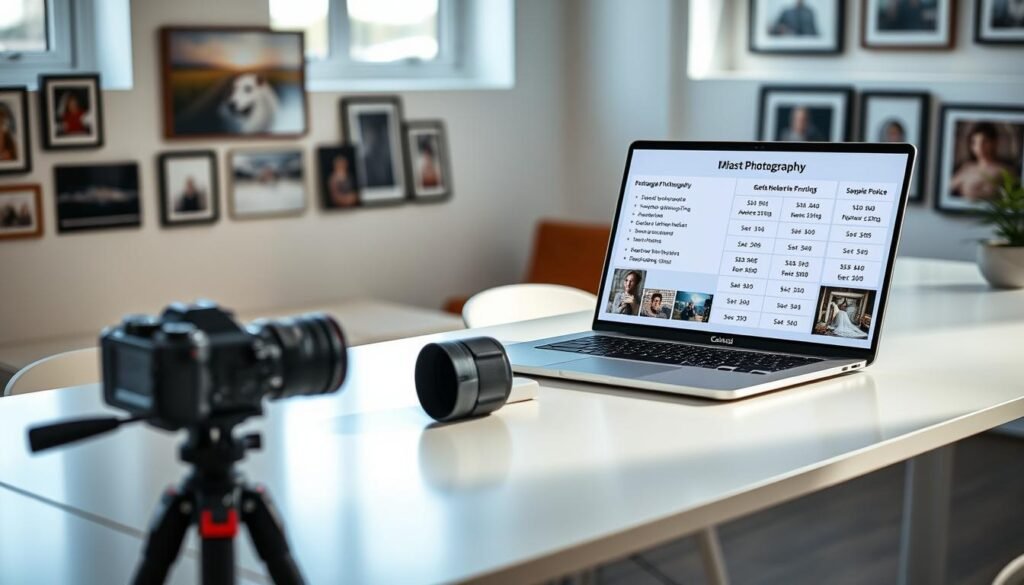Ever wondered why some photographers thrive while others struggle? Turning a passion into a profitable venture takes more than just a good eye and a camera. The journey involves legal setups, smart branding, and strategic investments—but it doesn’t have to be overwhelming.
Many beginners get stuck balancing creativity with paperwork. Licensing, pricing, and equipment choices can feel daunting. Yet, with the right guidance, even newcomers can build a sustainable career. Over 15 years, I’ve refined a system that skips costly mistakes and fast-tracks success.
This guide simplifies the process—from choosing gear on a budget to scaling operations. Whether you’re shooting portraits or events, the fundamentals remain the same. Let’s break down the essentials.
Key Takeaways
- Legal and creative aspects must work together for success.
- Affordable gear options exist for beginners.
- Branding sets you apart in a competitive market.
- Early mistakes can be avoided with proper planning.
- Growth requires adapting to client needs.
1. Define Your Photography Niche and Target Market
Successful photographers don’t shoot everything—they master specific markets. Specializing helps you stand out, attract ideal clients, and command better rates. While versatility has value early on, focused expertise builds recognition in your local market.
Consider this: 85% of wedding photographers also shoot engagements and family portraits. This shows how related specialties can complement your primary focus. The key is identifying where your skills meet demand.
Identifying Your Strengths and Interests
Begin by assessing your technical abilities and artistic style. Do you excel at documentary shots or posed portraits? Are fast-paced sports events or controlled studio sessions more your strength? Many professionals test different styles by offering free sessions to friends—a tactic I used successfully when building my portfolio.
Ask coworkers to model for practice shoots. This builds experience while creating portfolio samples. A Dallas photographer increased bookings by 40% after specializing in “adventure elopements,” proving that unique angles outperform generic approaches.
Researching Local Demand
Google Trends reveals underserved areas like pet or real estate photography in many regions. Study competitors’ pricing and service gaps in your area. Look for opportunities where your passion intersects with unmet needs.
Your brand emerges from this intersection of skill and demand. Whether you choose food, landscape, or event photography, commitment to a niche helps your photography business grow faster than trying to be everything to everyone.
2. Create a Solid Photography Business Plan
Behind every thriving photographer is a well-structured business plan. It bridges creativity and profitability, ensuring you invest money wisely while scaling strategically. Without this roadmap, even talented artists risk financial strain or missed opportunities.
Setting Short- and Long-Term Goals
Use the SMART framework—specific, measurable goals like booking 10 clients monthly within six months. A Dallas photographer doubled bookings by targeting local wedding venues, proving niche focus accelerates growth.
Break annual targets into quarterly milestones. Track progress with tools like Trello or Google Sheets. Adjust strategies if metrics lag, ensuring flexibility without losing sight of long-term vision.
Budgeting for Startup Costs
Keep initial startup costs under $2,000. Prioritize a midlevel DSLR ($400–$800) and premium lens over top-tier bodies. Adobe Creative Cloud ($9.99/month) and Squarespace ($120/year) are affordable essentials.
Adopt the Profit First methodology: Allocate 20% of earnings to gear upgrades. One Reddit user cleared $8,000 debt in 18 months using strict budget tiers—proof that disciplined planning pays off.
Research competitor prices to set realistic rates. Factor in hidden expenses like travel or editing software. A detailed budget transforms guesswork into predictable growth.
3. How to Start a Photography Business Legally
Legal compliance separates hobbyists from professional photographers. Proper registration and tax setups shield your income and reputation. Overlooking these steps risks fines—like the Arizona artist penalized $1,200 for uncollected sales tax.
Registering Your Business (LLC, DBA, etc.)
An LLC limits personal liability for under $200 via state websites. Services like ZenBusiness streamline filings for $49 plus fees. Texas photographers must also file a DBA through county clerks if operating under a trade name.
Obtaining Licenses and Permits
Local licenses—like a $75 occupancy permit—are often mandatory. Check county rules for studio or drone use. A Florida wedding photographer lost bookings after skipping a commercial filming permit.
Sales Tax and EIN Requirements
Rules vary by state: Utah taxes digital files; Georgia exempts services. Get an EIN (free from IRS) for business banking. QuickBooks Self-Employed automates sales tax tracking, preventing costly errors.
Custom contracts via LegalZoom further protect your startup. Addressing these steps early ensures smooth operations as you grow.
4. Essential Photography Equipment on a Budget
The right equipment doesn’t have to drain your savings if you know where to invest. Beginners often waste money on unnecessary items while missing critical tools that elevate their work. Strategic spending on core gear delivers better results than buying top-tier everything.
Cameras: DSLR vs. Mirrorless
Used Nikon D80 bodies ($50-$100) offer excellent starter quality, while the Canon Rebel T7 ($400) provides modern features. Mirrorless options like the Sony a6400 shine for 4K video with compact sizing.
DSLRs still dominate for battery life and lens affordability. Mirrorless systems win for weight savings and silent shooting. Test both types at local camera stores before committing.
Must-Have Lenses for Beginners
A 50mm f/1.8 prime lens outperforms kit lenses in low light and portrait quality. Many professionals use this $125 workhorse for 80% of their shots. The 85mm f/1.8 becomes valuable as you specialize.
One portrait photographer doubled bookings after upgrading to the 85mm. Renting from BorrowLenses.com ($30-$100/week) lets you test before buying.
Affordable Lighting and Accessories
$30 Neewer LED panels create studio-quality light for beginners. They’re 90% as effective as $500 Profoto units for most indoor work. Always carry backup SanDisk Extreme Pro cards ($25 for 64GB).
When buying used gear on Facebook Marketplace, verify shutter counts under 50k. This simple check prevents purchasing worn-out camera bodies that fail during critical shoots.
5. Building a Professional Portfolio
A powerful portfolio is your silent salesperson in the photography industry. It turns casual viewers into paying clients by showcasing your best work before you ever meet them. Start with 15–20 high-impact images that reflect your niche and style.
Offering Free or Discounted Sessions
Trade sessions for model releases to build content quickly. A lifestyle photographer booked 8 weddings after promoting “$30 Mini Sessions” on Instagram. Collaborate with local boutiques for styled shoots—their outfits become your props, and they share the photos for mutual exposure.
Showcasing Diverse Work Samples
Use Instagram Reels to display before/after edits, proving your technical skill. Platforms like Format.com create mobile-optimized portfolios with built-in SEO. Include client testimonials and metadata to boost visibility.
Pic-Time galleries let clients order prints directly, adding revenue streams. Every image should align with your brand—consistent editing styles and themes build recognition. Your social media feeds are extensions of your portfolio; curate them with the same care.
6. Crafting Your Unique Brand Identity
Distinctive branding turns casual viewers into loyal clients. Your visual identity—from logo to editing style—should communicate professionalism while reflecting your creative voice. A cohesive brand makes you instantly recognizable across websites and social media.
Choosing a Business Name and Logo
Skip overly creative names like “Shutterbug Dreams”—simple, memorable options perform better. Verify availability on USPTO.gov to avoid trademark issues. “Jenny Smith Photo” saw 70% higher recognition than abstract alternatives in a 2023 case study.
For logos, Looka.com generates professional designs for $65. Canva Pro ($12.99/month) offers editable templates with brand kits. Both ensure consistency across business cards and watermarks.
Developing a Consistent Visual Style
Color psychology matters: navy blue builds trust for corporate work, while gold accents suit luxury weddings. Pair classic fonts like Playfair Display (headlines) with Lato (body text) for readability.
Apply this style guide to all touchpoints—email templates, Instagram stories, and print materials. Consistency reinforces your brand every time potential clients encounter your work.
7. Setting Up Your Photography Website
Your online presence can make or break your photography venture before you even meet a client. A polished website builds trust, showcases your portfolio, and converts visitors into paying clients. Unlike social media, it’s a space you fully control—optimized for both aesthetics and functionality.
Platform Comparisons: Squarespace vs. WordPress
Squarespace leads with drag-and-drop simplicity and built-in SEO tools, outperforming Wix in search rankings. Its templates are mobile-responsive, critical since 60% of users browse on phones. WordPress offers deeper customization via plugins like Yoast—a photographer ranked #1 in Denver by optimizing local keywords like “maternity photographer” within 6 months.
WordPress requires more technical upkeep but scales better for growing businesses. Squarespace’s all-in-one hosting suits beginners. Flothemes bridges the gap with mobile-first designs for both platforms.
Essential Pages for Client Conversion
Four pages drive bookings:
– About: Share your story and credentials. Clients hire people, not just skills.
– Portfolio: Organize galleries by niche (e.g., weddings, headshots). Use Pic-Time for print sales.
– Investment: Transparent pricing reduces inquiry fatigue. Package sessions at $299/$599/$899 tiers.
– Contact: Embed Acuity Scheduling ($20/month) for instant bookings and reduce email back-and-forth.
Speed matters—compress images with ShortPixel to avoid losing visitors. A 1-second delay drops conversions by 7%. Test your site’s load time using Google PageSpeed Insights.
8. Pricing Your Photography Services
Smart pricing separates thriving photographers from those barely scraping by. Charge too little, and you’ll burn out. Set prices too high without justification, and clients look elsewhere. The sweet spot? Aligning your money goals with market demand.

Cost-Based vs. Value-Based Pricing
Cost-based pricing covers expenses like budget gear and editing time. For example, if sessions cost $200 to produce, charge $400 to ensure profit. Value-based pricing focuses on perceived worth—luxury weddings command $500/hour because clients pay for exclusivity.
Add 5% to cover payment processing fees. Tools like Tave automate proposals, ensuring transparency. A family photographer boosted revenue by 60% using print credits as upsells.
Packaging Sessions for Profitability
Bundle products to increase average order value. Offer tiers like Silver ($299), Gold ($599), and Platinum ($899). Position the Platinum Package as the premium choice—psychology shows clients often choose mid-tier options, increasing your earnings.
Upsell add-ons: $200 albums or $75 rush edits. Structured packages simplify decisions for clients while maximizing your time and profit.
9. Legal Contracts and Client Agreements
Misunderstandings with clients can cost thousands—unless you have airtight agreements. Contracts safeguard your business from disputes while ensuring clarity on deliverables, payments, and liabilities. Over 30% of photographers face nonpayment issues annually, making legal frameworks non-negotiable.
Key Clauses to Protect Your Business
Include a force majeure clause for weather or emergencies. A Colorado photographer avoided a $3,000 loss when wildfires forced cancellations—their contract specified rescheduling fees instead of refunds.
Define payment schedules and late penalties. Templates from The Law Tog ($297) cover state-specific tax rules and copyright transfers. Always require model releases for commercial work.
Using Tools Like Shootproof or Honeybook
Software streamlines workflows: Shootproof ($10/month) combines contracts with invoicing, while Honeybook automates reminders. Bonsai’s AI drafts custom agreements in minutes, ideal for bundling products like albums.
For liability, Hiscox offers $1M policies ($42/month). Pair e-signatures (DocuSign or Adobe Sign) with cloud backups to ensure compliance. Secure every client interaction—your reputation depends on it.
10. Marketing Your Photography Business
Strategic promotion turns casual scrollers into paying customers. Your social media presence and local connections work together to build a steady client pipeline. The right mix of digital and in-person tactics creates lasting visibility in your target market.
Mastering Visual Platforms
Instagram’s algorithm favors consistency—post 3-4 times weekly using a 30-hashtag blend. Mix 5 branded tags (like #SmithPhotoCo), 10 niche terms (#MaternityPhotographer), and 15 location tags (#DallasPhotographer). A wedding planner collaboration in Austin generated 12 bookings from shared Instagram Stories.
Pinterest drives long-term traffic when optimized. Create keyword-rich pin descriptions like “Boho Wedding Photography in Phoenix – Desert Sunset Portraits.” Boards should mirror your portfolio specialties, with fresh pins scheduled weekly via Later.com.
Building Local Authority
Google My Business listings convert 50% more leads when complete. Verify your profile, add service areas, and collect client reviews. One boudoir photographer doubled inquiries after adding “private studio near [landmark]” to her description.
Joint styled shoots with florists or bakeries split costs while expanding reach. Feature collaborators in your branded content—their shares introduce you to new clients. Facebook groups like “Best of Boston Weddings” delivered 50% of one studio’s bookings through member recommendations.
Attend chamber of commerce mixers with business cards showcasing your visual style. Local marketing creates a referral flywheel that digital efforts alone can’t match.
11. Booking and Managing Clients Efficiently
The difference between stress and success often lies in your booking system. Organized workflows prevent double-bookings, missed payments, and frustrated clients. With the right tools and policies, you’ll spend less time on admin and more time creating exceptional work.
Scheduling Software Recommendations
Platforms like HoneyBook ($40/month) automate inquiries, contracts, and invoices in one place. Its CRM tracks clients from first contact to final delivery. For smaller studios, 17Hats offers similar features at lower tiers—perfect for those managing under 20 sessions monthly.
Integrate Typeform with Zapier to route inquiries directly to your calendar. A Chicago portrait photographer reduced no-shows by 75% after implementing $100 non-refundable deposits via Stripe. Always avoid Venmo for payments—it lacks dispute resolution and tax documentation features.
Communication Best Practices
Set a 90-minute response time policy using templated replies. Quick responses signal professionalism and prevent clients from booking elsewhere. For complex projects, schedule discovery calls through Calendly to clarify expectations upfront.
Offer flexible payment plans with 50% deposits to secure bookings. Highlight your products during consultations—studios that showcase sample albums during meetings see 40% higher add-on sales. Clear communication turns first-time clients into repeat customers.
12. Delivering an Exceptional Client Experience
Client satisfaction transforms one-time buyers into lifelong advocates. Exceed expectations at every stage—from the first inquiry to final delivery—and your work will speak for itself through referrals and repeat bookings.

From Consultation to Final Delivery
Welcome kits set the tone. Include a prep guide with outfit tips and location ideas. A surprise 8×10 print with orders delights clients and boosts loyalty.
Stick to a 2-3 week turnaround for photos. Clear timelines manage expectations. Anniversary discounts encourage repeat bookings—one studio saw 35% returning clients with this tactic.
Online Gallery Tools
Platforms like Pic-Time offer built-in print fulfillment, saving time while upselling products. Mobile-first gallery designs ensure seamless viewing on any device.
CloudSpot’s feedback loops help refine your process. Invest in software that automates delivery, so you focus on creativity, not admin.
13. Scaling Your Photography Business
Growth in the photography industry demands strategic upgrades and smart delegation. As bookings increase, reinvesting profits wisely separates sustainable ventures from stagnant ones. The right balance of gear investments and team support lets you handle more clients without sacrificing quality.
Investing in Advanced Equipment
Prioritize full-frame cameras once you’re booking 15+ paid sessions monthly. The Sony a7 IV ($2,500) delivers professional results for portrait and event work. Follow with lighting upgrades like Profoto A10 flashes ($1,000) before adding specialty lenses.
Calculate ROI before major purchases. A $3,200 Sony GM lens pays for itself if it helps secure 8 additional bookings annually. Renting high-end gear for specific projects tests performance before buying.
Building Your Support Team
Outsource photo editing first at $25-$50/hour. Platforms like ImagenAI cut culling time by 80% at $0.05 per image. For in-person shoots, hire freelance assistants through local photography schools.
Consider associate photographers once you’re turning down work. A Chicago studio doubled revenue by onboarding two contractors at 60% commission. Always use independent contractor agreements to protect your business.
Create passive income with Lightroom preset packs ($29-$99) or online courses. These revenue streams require minimal ongoing money or time while expanding your brand’s reach.
14. Conclusion
Launching a successful venture requires balancing creativity with strategy. Focus on legal foundations, a standout portfolio, and targeted marketing to attract ideal clients.
Download our free checklist to streamline your first steps. Smart investments matter—upgrade gear only when it directly boosts earnings.
Join our Facebook community for real-world advice. With the right approach, your first paid session could be just weeks away.
Every pro started where you are now. Take action today, and your passion will soon pay off.
FAQ
What’s the best way to choose a photography niche?
Focus on your strengths and passions first. Research local demand to see what clients need, whether it’s weddings, portraits, or commercial work.
Do I need a business plan for a photography startup?
Yes. Outline short- and long-term goals, plus startup costs. A clear plan helps track progress and secure funding if needed.
What legal steps are required to launch?
Register your business (LLC or DBA), get necessary permits, and apply for an EIN. Check state sales tax rules for compliance.
Can I start with budget-friendly gear?
Absolutely. A DSLR or mirrorless camera with a versatile lens works well. Add affordable lighting like softboxes or reflectors for professional results.
How do I build a portfolio without paid clients?
Offer free or discounted shoots to friends and family. Showcase diverse styles to attract potential clients.
What’s the key to strong branding?
Pick a memorable name and logo. Keep visuals consistent across your website, social media, and marketing materials.
Which website platform is best for photographers?
Squarespace offers sleek templates, while WordPress provides customization. Include galleries, pricing, and contact pages for conversions.
How should I price my services?
Factor in costs (gear, editing time) and market rates. Offer packages to upsell clients and boost profits.
Are contracts necessary for every shoot?
Yes. Use tools like Honeybook or Shootproof to draft agreements covering payments, cancellations, and image rights.
What’s the fastest way to attract clients?
Post regularly on Instagram and Pinterest. Network locally with vendors and venues for referrals.
How can I streamline client bookings?
Use scheduling software like Calendly. Set clear communication guidelines to avoid misunderstandings.
What tools help deliver photos professionally?
Online galleries like Pic-Time or Pixieset let clients view, download, and order prints seamlessly.
When should I upgrade my equipment?
Invest in better gear as you earn more. Consider hiring assistants or editors to handle growing demand.






